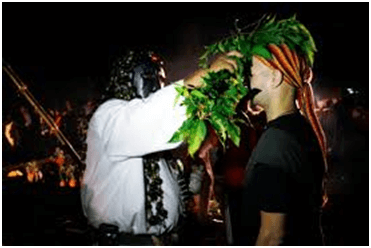Bernardo Ng
San Diego, California, United States

Witchcraft has been present in the Mexican culture for centuries, both in and out of the context of disease, with witches practicing either white or black magic. The most nationally recognized site for witchcraft is the city of Catemaco, Veracruz, on the Gulf of Mexico. The white magic witches, also called curanderos or healers, most commonly offer a limpia or spiritual cleansing; those practicing black magic offer “spells” or curses.i, ii, iii Services provided by witches are available practically anywhere in Mexico, as well as in cities with a significant Mexican population in the United States. This case is an illustration of a person navigating a culturally bound activity, from a state of marital disruption to one of frank psychosis and disability. This topic has unfortunately fallen off the interest of the medical and social sciences and become more of an interest to the media.iv
Jane was born in a rural community in California. Her parents were migrant workers from Mexico who settled in this community in the 1930’s. She was the second of five children. One of her siblings was schizophrenic, another intellectually disabled. They spoke at her house primarily Spanish, yet the siblings also spoke a mixture of English and Spanish.
Jane attended school and contributed to the household income with part-time jobs as a field worker. Towards the end of high school, her father determined that she had “gone to school long enough” and forced her to drop out of school and work full time.
Soon after, she was “kidnapped” by her soon-to-be husband. The act had the pretension of being “against her will” so as to secure her honor. They traveled out of state and got married that night. Their first years together were great. They became popular dancers in their community and people would come to the same night club merely to see them dance. Although she was a housewife and a mother for most of her married life, Jane intermittently worked in agricultural activities to supplement the family income.
They had four children and decided to move to her husband’s hometown, a small community close to the Mexican border. At first they thought it was a better place to raise their children, but later it became a problem as Jane learned that her husband was cheating on her. In order to solve the problem, she decided to get the services of a witch to assist in keeping away any women interested in her husband. She was convinced that a spell had been placed on him so that he would leave her.
According to witchcraft tradition an unmarried man or woman may solicit services to attract, control, or subdue a potential mate. This practice can also be used to “separate” a marriage on behalf of an interested third party. So far, Jane’s belief system was congruent with her cultural and social environment.v, vi Jane’s husband admitted that he did have an extramarital affair, and as she gained knowledge of this she sought help from a witch. Her wish was to “undo” the spell she believed had been cast on him by another witch. Unfortunately the spell she ordered “reverted” on to her, causing extraordinary changes in her behavior.
She developed the belief that several “spirits” commanded by her husband’s lover lived in her dwelling and interfered with her life. She was in a constant state of vigilance, tension, and fear; often attributing common noises of the house’s wood frame, the wind, or noises made by domestic animals to the presence of spirits. She could actually hear and see spirits (i.e. auditory and visual hallucinations), and her husband described explosive behavior and unprovoked angry outbursts in the middle of the night. She became aggressive towards her family members and household property, exhibiting long and incoherent monologues and odd gestures as if trying to “scrub” something out of her hands and arms, becoming socially withdrawn, taciturn, and distracted, unable to complete domestic tasks, and eventually unable to maintain her personal hygiene and appearance. She became so sick that her husband took her to see a physician; however, they also did not stop seeing witch healers. Their hope was to remove the curse that had “reversed” on her.
According to her husband, Jane responded well to the healers’ interventions, and after each limpia would calm down, more coherent and less paranoid, with fewer hallucinations and improved overall functioning ability. This progress would only last two or three months, then her symptoms returned.

This cycle happened one last time in her early forties, when Jane was taken to Mexico in order to perform another limpia. The cleansing ceremony was performed by an elderly woman who refused to accept any payment. During this cleansing several animals in the property appeared to die spontaneously, and a number of visual cues were offered as proof that the evil spirit had been removed. The elderly lady, however, did not offer any guarantees and warned the husband that Jane was already very “weakened” by years of being under a malignant spell.
This limpia came with remarkable improvement and Jane resumed activities she had stopped for years, including sexual intercourse, housekeeping, cooking, and grocery shopping. But after four months she began to exhibit signs of distress, again becoming hypervigilant, jealous, and paranoid. Her aggressive behavior increased, as did her consumption of alcohol. It was around this time that the family began to suspect that Jane had a mental disorder rather than being under a spell. They took her to a psychiatrist, who started her on pharmacological treatment. The results at first were not encouraging, as Jane’s emotional state fluctuated between total despondency, fear, crying spells, and constant hallucinations to periods of relative peace and tolerable symptoms.
I first met Jane when she was almost fifty years old. I was her seventh psychiatrist. She suffered at the time of a deep sense of fear that a male witch had hexed her, claiming that he had fallen in love with her, ordered her to leave her husband for him, and was cursed to be sick for the rest of her life as she could not get rid of him. This witch kept visiting her in the form of a “living spirit.” She could feel his touch, his penis in contact with her genitals trying to penetrate her, his hands against her breasts, buttocks, neck, and back. The spirit would not let her sleep or eat, drained all her energy, and gave her palpitations, chest discomfort, abdominal distension, headaches, difficulty in breathing, and weakness. At night she would get up to take showers to get rid of his presence, and would cover her genitals with toilet paper to prevent being penetrated.
According to her husband, a witch that had fallen in love with her did exist. His “work name” was Noel, but they had learned that his actual name was Leon. He had tried to establish a personal relationship with her, which she turned down. Her symptoms improved with the antipsychotic medication clozapine, but her functional level remained limited. But within a few years she did not tolerate the clozapine because of side effects and had to enter a skilled nursing skilled facility. Eventually the dose of medication could be reduced, but as she was already in her mid-sixties, she was afflicted by many other complications and serious health conditions. The idea of the male witch visiting her remained present until the time she died, however the fear surrounding his presence and his visits diminished, she was able to forgive her husband and maintain a reasonable relationship with him and her adult children.
Although there was an important history of psychiatric illness in Jane’s family, it is only after she entered the world of witchcraft that her symptoms began. Her psychotic symptoms stemmed from a “healing practice” sanctioned by her culture and accepted by her husband, friends, and acquaintances, and it took her family almost 2 decades to realize that she needed psychiatric care. She never returned to her earlier state of health, but with treatment attained the best quality of life since she became ill. Important in this partial yet significant success was a health care provider’s acceptance of her beliefs in “witch healers” to the same extent that her family and her community did.vii Clinics and mental health providers are encouraged to include space for the discussion and understanding of witchcraft and spiritual beliefs in their programs and practices.viii, ix
End notes
- Gutierrez “bruhos en Catemaco”
- brujosdecatemaco.org
- littleredridinghood
- Jordan “Mexican witches”
- brujosdecatemaco.org
- littleredridinghood
- Warner “Witchcraft and soul loss”
- Codjoe “Exploring perceptions”
- Smith “Ethnomedical syndromes”
References
- Brujos de Catemaco. https://brujosdecatemaco.org/
- Codjoe, Louisa, Majella Byrne, MatthewLister, Phillip McGuire , and Luica Valmaggia. “Exploring perceptions of “wellness” in black ethnic minority individuals at risk of developing psychosis.” Behav Cogn Psychother 41, no. 2 (Oct 2012):144-61. https://doi.org/10.1007/s11013-009-9145-3
- Gutierrez, Arturo. “Por qué hay brujos en Catemaco? http://viamexico.mx/brujos-en-catemaco/
- Jordan, Mary, Kevin Sullivan. “Mexican witches cast year-end spells.” Washington Post, Dec 28, 2000, https://www.washingtonpost.com/archive/politics/2000/12/28/mexican-witches-cast-year-end-spells/074d4923-5cc7-4e18-82bd-354515ddd64d/?utm_term=.08ff280102cc
- littleredridinghood “Traditional witchcraft and occultism.” Last modified Jan 2, 2014. https://traditionalwitchcraftandoccultism.wordpress.com/category/mexican-witchcraft-2/
- Smith, Bryce D., Miriam Sabin, Elois Ann Berlin, Larry Nackerud. “Ethnomedical syndromes and treatment-seeking behavior among Mayan refugees in Chiapas, Mexico.” Cult Med Psychiatry33,no. 3 (Sep 2009):366-81. https://doi.org/10.1017/S1352465812000707
- Warner, Richard. “Witchcraft and soul loss: implications for community psychiatry.” Hosp Community Psychiatry 28; no. 9 (Sep, 1977):68.
Photo credit
Photos were obtained from www.brujosdecatemaco.org.
BERNARDO NG is a psychiatrist born in Mexico, who trained both in the United States and Mexico. He spends most of the time providing direct patient care on both sides of the United States and Mexico border. His areas of interest include border issues, rural psychiatry, minority mental illness, migration, and latino mental health.

Leave a Reply